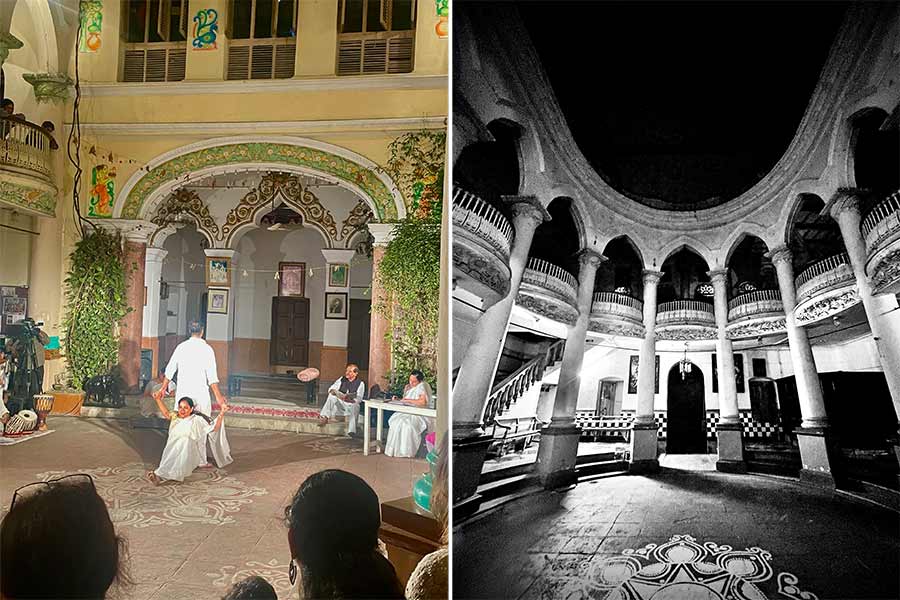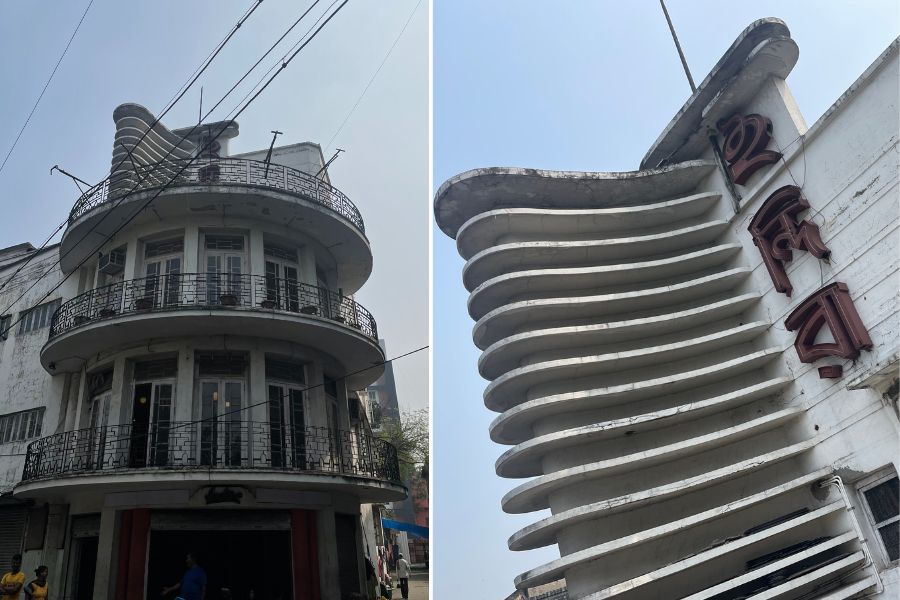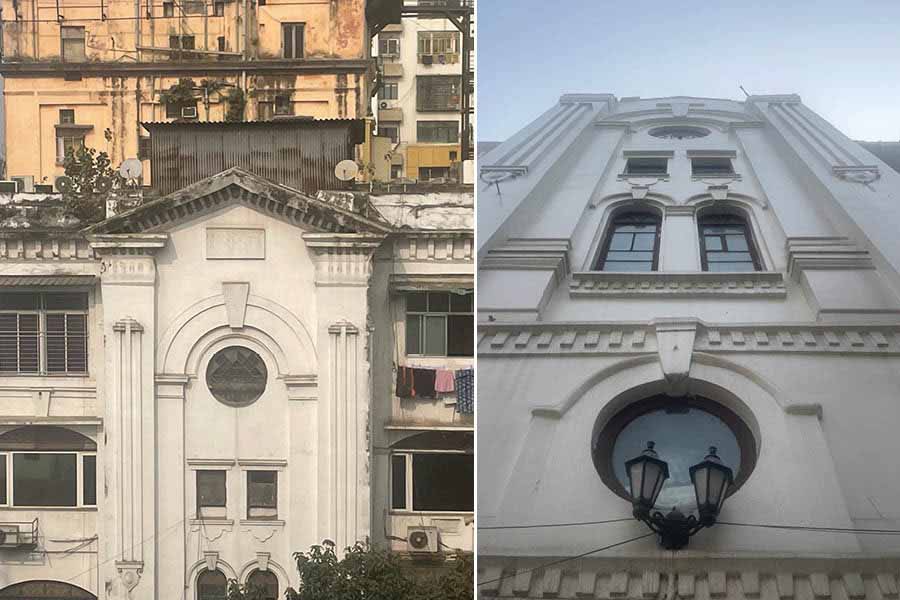An unusual adaptive heritage reuse experiment transpired at the Shib Krishna Daw Bari in north Kolkata in early March 2024. Padatik, a prominent theatre group, enacted a play within this heritage premises (late 18th century vintage by one account though one would rather place it around the middle of the 19th century), stirring the dust of the decades.
This could have been just another play for most but for reasons that made the exercise distinctive.
One, the play was ticketed confidently at Rs 400, a departure from the ‘Who will buy at this price?’; most who attended brought passes off Bookmyshow, extending the prudent use of digital technology to a conventional format. Two, the play was not in Bengali as one would have expected for a location that was so typically north Kolkata; it represented the distilled Urdu of Ismat Chughtai. Three, 90 percent of the attendees drove in from south Kolkata (act of courage) through the bazaars of Chitpore. Four, the seating needed to be reimagined, considering that when the property had been reconstructed, most would have been content sitting on the marbled zameen, but we now had a tonied gathering to be accommodated on chairs.
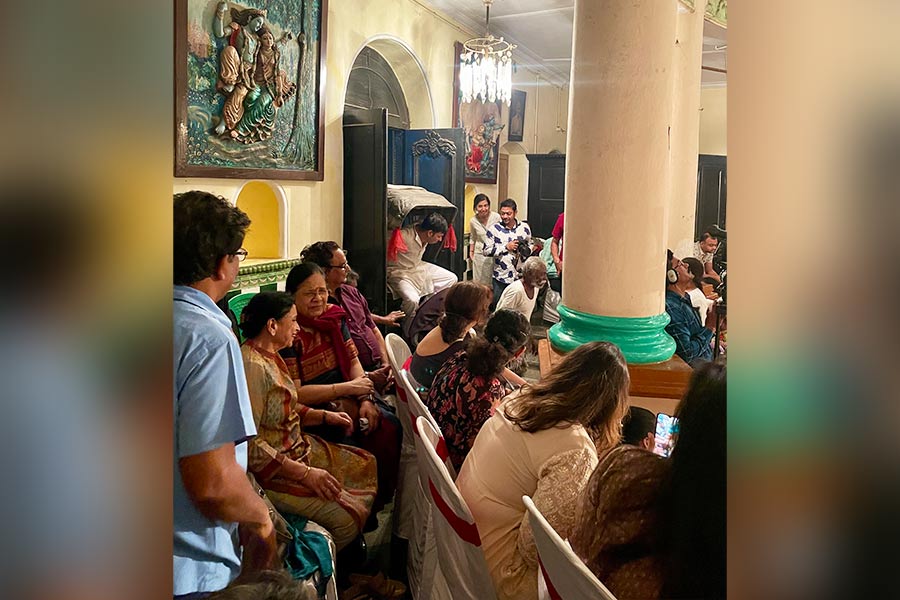
A tonied gathering had to be accommodated on chairs
Each of these factors could have prompted a ‘Let us shift this to somewhere else’. Padatik (inspired by Anubha Fatehpuria) hung on; it felt that the air-conditioned gaddiwala theatre model had been overdone to the point that nobody felt anything different was even plausible. Padatik differed and turned to the positives: one, ‘Daw Bari’ sent out an exotic message of a location where history could be cut out of the air with a spoon; some attendees who never ventured to explore Calcutta northwards of New Market saw this as a magical mystery tour; the audience felt that this was as authentic a theatre experience as one could get with actors almost eyeball-to-eyeball in some cases (‘as if she was speaking to me’); the exercise of getting off Audis and walking through the lane to the location provided a time freeze perspective into how a part of Calcutta still lives; by being able to experience theatre the way it was performed before the microphone age – not one artificial amplifier was used during the play – was like turning the clock back. The word someone used was ‘pure’.
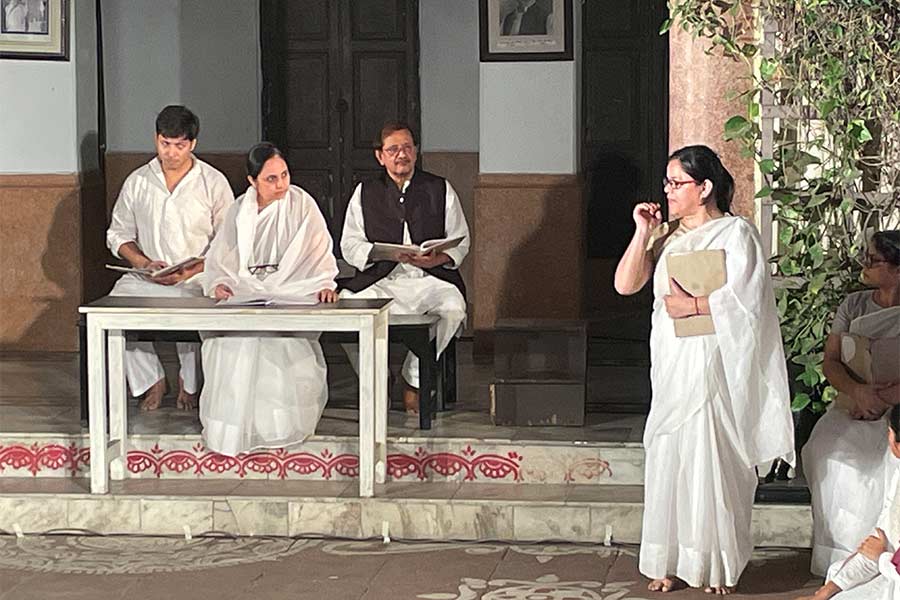
A scene from the play
Padatik didn’t just take it as it came; it built upon. It would have been easy to congregate, enact and leave; Padatik ensured that the property owner was remunerated – no deployment of ‘We are doing this for the good of the city, so can you give us the use of the place free’ – so that every contributed rupee (coming from ticketed people like you and me) could be deployed directly in built-heritage conservation. It took the adaptive reuse proposition beyond the usual: its performers delivered dialogues from the first-floor balconies, a protagonist cycled into the premises, a dulha-miya was wheeled in on a hand-drawn rickshaw and when the dialogue carried a reference to Lucknow ki sevai, the cast support group leaped into action sharing a tray full of sevai-kheer with every audience member (without interrupting the play). A lady in front nodded in appreciation; none of this could have been attempted in a 600-seater auditorium; one of the audience described the locational romance succinctly. She used the word ‘immersive’.

The cast support group share sevai-kheer with audience members
The story of immersive theatre at Shib Krishna Daw Bari would be incomplete without a reference to the people who made it possible. The family. In 1770, Gokul Daw travelled from Burdwan to seek a living in Calcutta; presumably, he became affluent enough to buy an extensive property on the lane named after him, which extends across three contiguous Daw sub-properties ending on Vivekananda Road. For our relevance, the gamechanger in the family was Kirti Chandra Daw, who lived between 1887 and 1924. To put him in context: he was 14 when Swami Vivekananda passed away not far from where he lived; he was 18 when Bengal was partitioned; he was 24 when the capital was shifted from Calcutta to Delhi; throughout his life, he lived within 200m of the greatest poet Bengal has produced. Completely influenced.
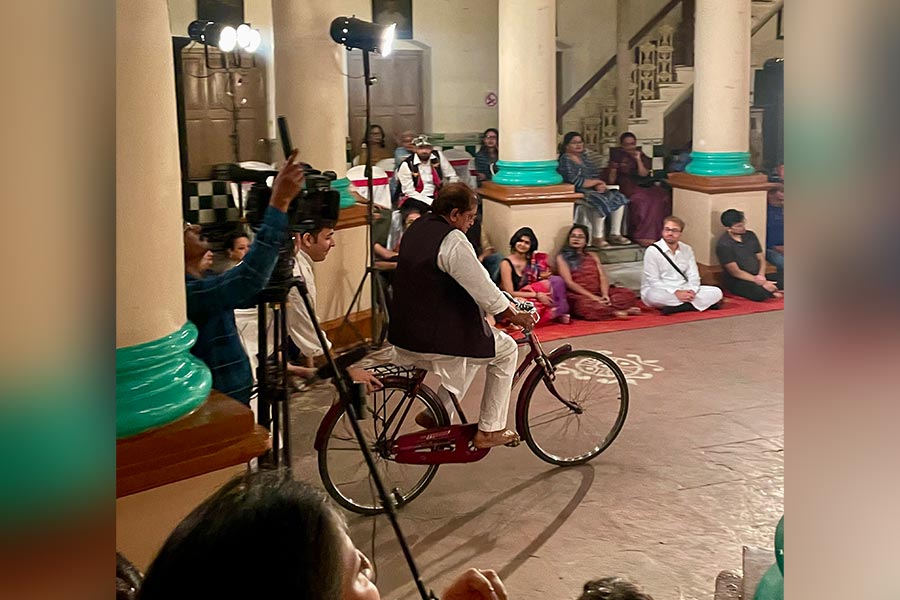
Padatik ensured that the property owner was remunerated, so that every contributed rupee could be deployed directly in built-heritage conservation
His was an unusually short life even by the high mortality average of that time, marked by an important detail. In 1919 (when 32) Kirtibabu embarked on the renovation of his multi-decade property. Not restoration, but renovation. He embarked on something that would have had him hauled by the later-day Heritage Committee. He engaged Burn Standard to redesign the rectangular balconies on the first floor of his heritage residence that overlooked the central courtyard (uthon) into small oval equivalents. I can read his mind: ‘I am going to design these balconies around the opera houses of Europe. We will create oval cubicles with customised grills from where the women of our family will be able to watch theatre below without being seen by anyone in the audience. I will transform this home into a centre for the performing arts for amader lok. Why should we have to turn to the British for halls and theatres when we can modify our homes and use them for enriching our culture?’ Theatre and performing arts would be adapted around homes; Kirtibabu was adapting his residential architecture around theatre and performing arts.
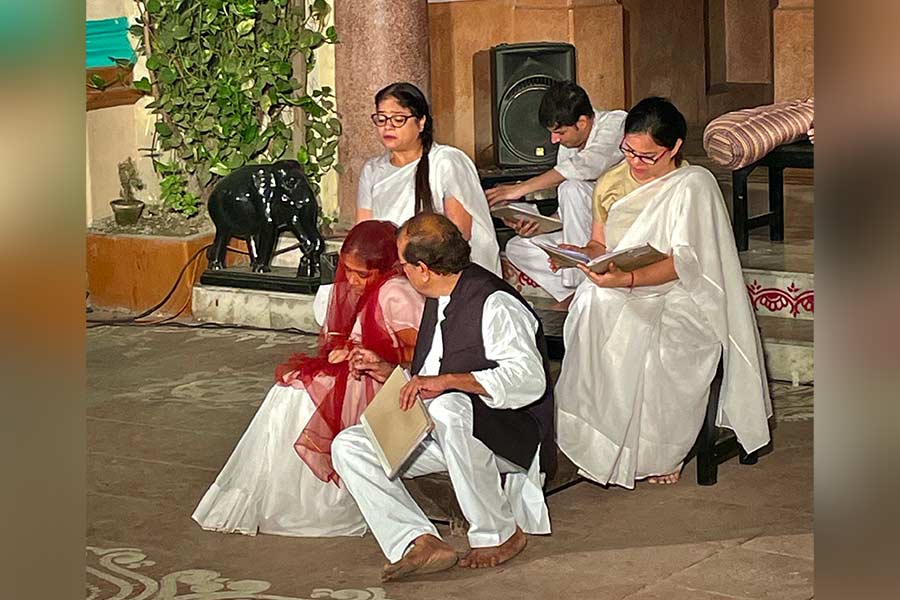
Another scene from the play
Kirtibabu’s was a short 37-year life. His contribution would have gone with him; succeeding family members – presumably too young to buy into his rationale – could have said ‘With him gone, where is the passion to sustain theatre?’ Surprisingly, the reverse transpired. Maybe Kirtibabu’s brothers (whose assent must have been sought before the renovation) said ‘We will complete what he could not.’
This is how one person’s dream transformed into a gharana. In the following decades, a performing arts culture deep-rooted within Shib Krishna Daw Bari. Musicians would be requested to perform; the neighbourhood would be invited. Theatre groups would be encouraged to conduct their last rehearsals. On the eve of Boro Din (in this case Poila Boisakh), multiple theatre groups would be allocated time slots of two hours each; the entire neighbourhood would be served a hurried dinner before they left for Daw Bari, select their places on the uthon, corridor and cubicle floors, watch different plays one after another into daybreak (‘raat jege’), then stagger homewards to prepare for school or chakri.
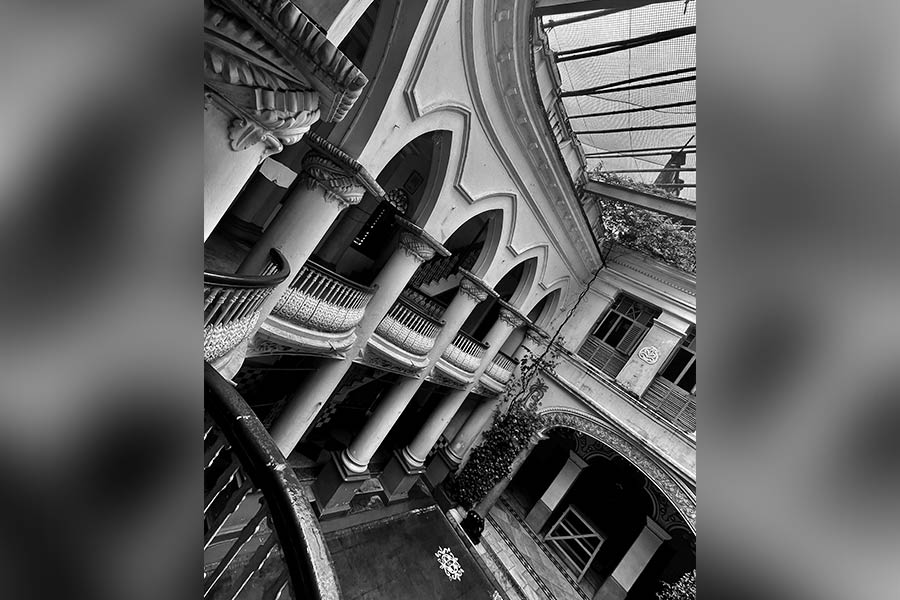
On the eve of Boro Din (in this case Poila Boisakh), multiple theatre groups would be allocated time slots of two hours each
These nights became more than occasions to congregate; they became institutions within the collective memory of all who lived within 200m. They became a motif of a simple age when neighbours spent their evening leisure hours on ‘rowaks’ dissecting Jallianwala, Gauhar Jan, Gandhi, Subhas Bose and Civil Disobedience. They became democratically the closest to an affluent gramophone or buying expensive tickets to a bioscope.
Then came the technology age. It became more convenient to push buttons on electronic contraptions in exchange for performances at a whim. Spontaneous performances yielded; canned entertainment emerged; crowds thinned. Those who would sit through night-long engagements now began to take apologetic leave by midnight. Homeowners felt that with the crowd thinning, performance fees needed to be renegotiated. Performing groups felt that with the decline of the roshiks and patrons, they needed fewer actors on their ship.
Then one day, someone said: ‘Let us not organise anything this year.’ Actors froze. Voices stilled. Lights dimmed. The only time in the year when Daw Bari reverberated with footfalls was possibly during Durga Puja. Or for the occasional heritage walker leading awed guests and weaving stories of the way people once lived from a complement of grills, brick, lime and plaster. Until they came a time when the echoes receded.
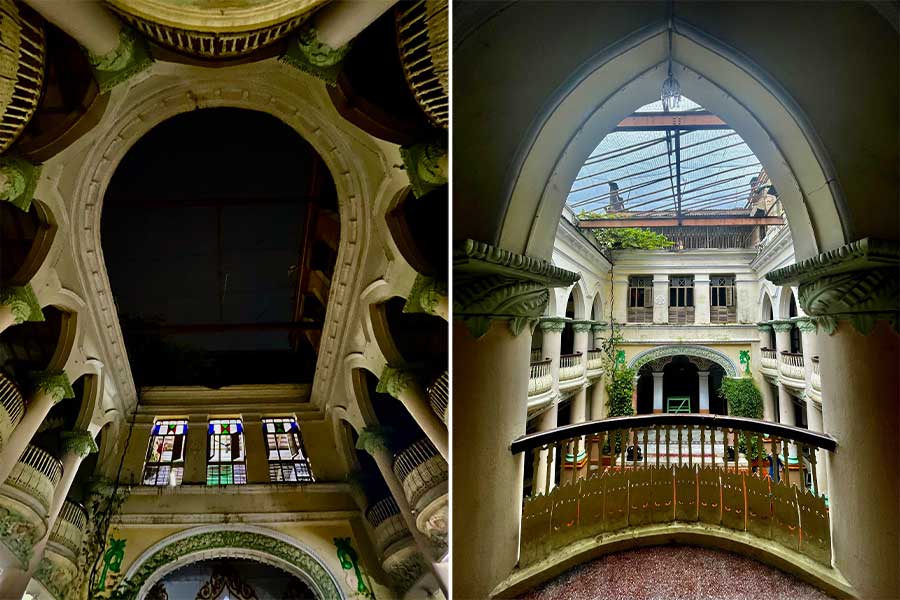
If more theatre or performances could be conducted in such locations, that could represent a reimagining of how our heritage spaces can be promoted, used sustainably and bring them into our collective consciousness
Returning then to Daw Bari with professional theatre in early March 2024 represented more than just a change in entertainment location; it represented the revival – however fleeting – of an art form within an architectural context that most had forgotten or considered mismatched. If more theatre or performances could be conducted in such locations, that could represent a reimagining of how our heritage spaces can be promoted, used sustainably and bring them into our collective consciousness.
There will be challenges of seasonality – Kolkata hibernates culturally between March and September – but if we can overcome fears of humidity and rain by classifying locations across moods, theatrical themes and seasons, the result could be a relatively affordable, symbiotic and enriching cultural calendar.
Then – and only then – would the classic Bengali line of ‘Baaro mash, tero parbon’ be complemented by performances within neighbourhoods, deepening a conviction that Calcutta remains one of the last great cultural places to live in.
